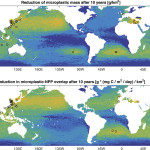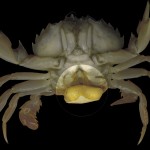Biochemcial adaptations to temperature and pressure are essential for organisms to exploit the deep sea. The prominent physiologist, George Somero, whose work has repetitively inspired and defined several sub-disciplines of biology, published a review of these adaptations in 1992. Here I largely translate his work and provide the necessary background material for you to digest the modifications exhibited by denizens of the deep.
As you may remember from high school or college biology, a cellular membrane consists of lipid bilayer. The major membrane lipid is a phospholipid. One end of this molecule is polarized consisting of both a negatively charged oxygen attached to the phosphate and a positively charged nitrogen group. To this ‘head’ is attached to two noncharged fatty acid ‘tails’. The polarized end is thus hydrophilic (i.e. water ‘loving’ because of the charges on a water molecule) and the fatty acid tails are hydrophobic. The polar regions of the phospholipids are oriented toward the surfaces of the membrane as result of their attraction to the polar water molecules in the fluid both inside and outside the cell. The important thing to remember is no chemical bond connects adjacent phospholipids. The structure is entirely maintained by the interaction of charges (or lack of) between water and the phospholipids. This makes the membrane semipermeable much like a layer of oil on water. But wait… Pressure increases 1atm for every 10m, so deep-sea organism can experience a range of pressures from 20atm at the shallowest point to 1100atm in the deepest. This results in a tighter packing of the phospholipids which lower the permeability of the membrane. But wait it gets worse…Temperatures in the deep are typically near 4 degrees C and near the poles water can become supercooled to -1 degree C. This also decreases the permeability of the cell membrane.
One adaptation to increase cellular permeability is to increase the percentage of unsaturated fatty acids. In a saturated fatty acid all the carbons in the chain are lined by a single covalent bond. As you recall, a carbon can take four chemical bonds. If all these bonds are covalent (single) then a carbon could potentially attach to 4 other atoms. Thus the saturated comes from the fact that the carbon chain is loaded with hydrogens. If a carbon forms a double bond with another atom then the carbon would have to bond with one less hydrogen. Thus an unsaturated fatty acid is one with double bonds and not ‘saturated’ with hydrogens. The double covalent bond between adjacent carbons in an unsaturated fatty acid leads to a ‘kink’ in the tails of the molecule. Thus increasing their concentration in membrane leads to a looser packing.
At the basic level, temperatures and pressures would also select for enzymes with different temperature sensitivities and pressure resistances. Changes in protein structure can influence their cellular function. Thus selection for rigidity is needed to counteract pressure. Proteins contain hydrogen and disulfide bonds between different subunits and parts of the amino acid chain that both dictate structure. A selection for proteins with increased bonding would minimize changes in shape to do pressure.
The previous examples represent the most basic biochemical adaptations needed to survive in the deep sea. Unique environments with in the deep sea such as anoxic/hypoxic regions (i.e. zero or little oxygen) require at a minimum alterations to proteins to increase oxygen binding efficiency and transport. Extreme temperature gradients experienced at hydrothermal vents present unique challenges. For example, hydrothermal vent worms such as Alvinella can experience 22 degrees C near the gills and 60+ degrees C near the body trunk. Hydrothermal vents and methane seeps also place animals in close proximity to potentially toxic levels of chemicals. The most abundant of these is sulfide that many vent/seep organisms require for their symbionts. For many organisms, in the absence of ambient light, bioluminescence becomes important in ecological interactions. Steve Haddock has a wonderful website that explains both the chemistry, physiology, and everything else about this topic.
I won’t discuss these specific adaptations further as the topic could fill a book. What you should know is the interesting biological puzzle inhabiting the deep presents for organisms. It is a tough life. For more reading, I direct you to two excellent papers from the experts themselves.
Somero, G. N. 1992. Biochemical ecology of deep-sea animals. Experientia 48:537-543.
McMullin, E. R., D. C. Bergquist, and C. R. Fisher. 2000. Metazoans in extreme environments: adaptations of hydrothermal vent and hydrocarbon seep fauna. Gravitational and Space Biology Bulletin 12:13-24.
Also see…
Gage, J. D., and P. A. Tyler. 1991. Deep-Sea Biology: A Natural History of Organisms at the Deep-Sea Floor. Cambridge University Press, Cambridge.
Share the post "25 Things You Should Know About the Deep Sea: #15 Living in The Deep Requires Biochemical Adaptations"






A naive question – how deep is the Deep Sea? For example, if a new species of fish such as Cryothenia amphitreta were discovered at a depth of only 20 meters, would that fall under your purview?
See http://scienceblogs.com/deepseanews/2006/12/archive_25_things_you_should_k.php
This is the kind of news I like to hear. Thank goodness for AP Biology, cause without what I learned at the beginning of the semester I would have no clue what you were talking about with the phospholipid bilayer. It’s so amazing that they can live near the thermal vents. I wish I had the equipment and devices to get that deep in the water. I have scuba dived before, but it could never compare to how cool it would be down there. Seeing those amazing deep sea organisms would just be out of this world. Some of them look so eccentric. My teacher had us come up with some ideas of how the deep sea temperatures would effect enzyme activity and membrane fluidity. Mine were good, but definitely not specific enough. I wasn’t even thinking about the saturated and unsaturated fatty acids. That threw me for a loop. Thanks for the info. Keep up the good work on the “25 things you should know about the deep sea” series. It’s good that I can get Biology info from class and marine biology articles from here.